Group the same applications from different stores by icon
Once I had the misfortune to turn my gaze to one tempting job. All anything, but, as usual, threw a test task. In short, it was necessary to group links to the same application in different markets. The links were applications such as Skype, Skype WiFi, Skype Qik, Viber, and two games with the same name Skyward. The stores included Google Play, the App Store and the Windows Phone market. In the task there was also a description of the rake, they say, it is not necessary to become particularly attached to the names of applications, the name of the developer’s company, etc. “But after all, identical applications are easily recognizable on different platforms stupidly by the icon,” I thought, and it’s helpful to find out the details. But not everything is so simple.
This is how icons in different stores for Viber and Skype look like:

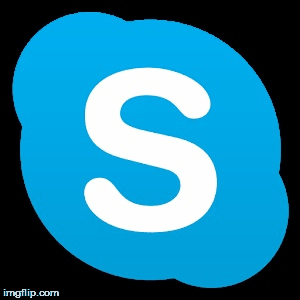
Icons, alas, differ in color set and size. The initial idea to hash the icons and compare the hashes, of course, still serves, but not in this case. Initially, I made a mistake by pulling out for analysis the icons that are shown in my browser, and they are rather small in size. A little later, after digging, I found sizes from 300 to 350 pixels, which added accuracy in measurements. In general, the code with which pictures are dragged is quite simple.
')
For my task, I googled the OpenCV library. This is a very advanced tool for various image analysis. Initially, I was so carried away that it was useful to study feature matching, but this is somewhat not what was needed. But I needed to highlight the outlines on the images and somehow compare them.
To construct the contours, it is necessary to properly prepare the image - select the borders on it. To do this, we use the detector Kenny (Canny). Maybe Kanni will be right, I don't know. It works like this:
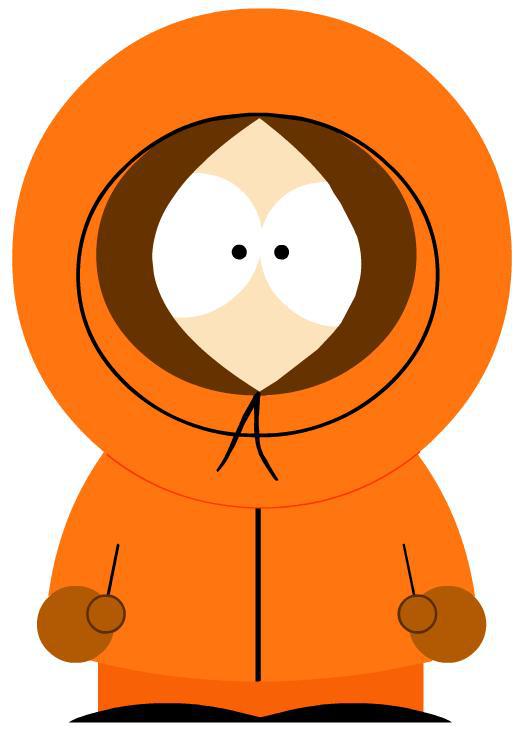

In the case of the Skype icon, the following results were obtained:
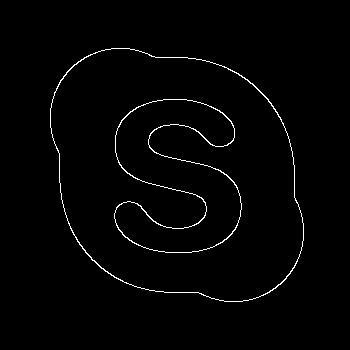
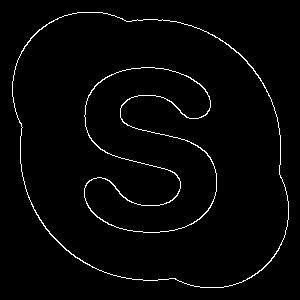

It may seem that only the size remains of the differences, but it is not. The highlighted borders are slightly different, and bringing the icons to the same size only adds errors.
The only problem is to choose the minimum and maximum thresholds for the algorithm correctly. Values of 100 and 200 absolutely suited me.
Next, we find the contours. They can be compared by calculating the coefficient of coincidence of the two contours - a very useful property in my task. There is a nuance - this angle is not affected by the angle of rotation of the contour, but in my case it almost does not make the weather. For Skype from Google, the result of contouring is as follows:
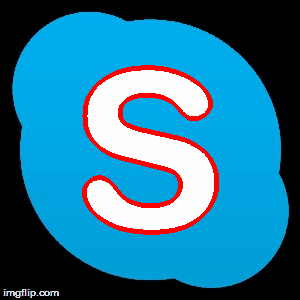
There are not two circuits, four of them. The contour is constructed from the outside and inside of the previously defined boundaries. I searched the contours with the RETR_LIST flag, that is, without a hierarchy, and then sorted from the upper left edge of the image.
For my algorithm, you also need to calculate the total length of the contours - in OpenCV there is for this a separate function arcLength . The algorithm itself is reduced to the fact that if the two images coincided more than 80% percent of the length of the contours, then we consider these images as the icon of one application. The contours themselves are compared by the matchShapes function, the smaller its result is, the better, in my case, the upper limit of the contour matching was 0.15.
However, there is still a second type of icons that could not be compared using this algorithm — these are Skyward game icons:
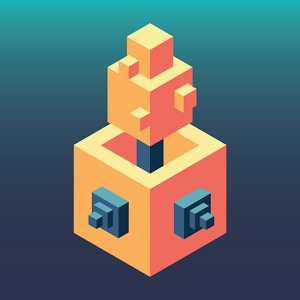

At the time of writing, these icons differ in color, but some time ago in two stores was the first color option. The icons differed only in size, but because of this, the outlines did not coincide at all, and nothing could be determined by them. However, the imagehash library helped me here. For the game Skyward, hashes turned out to be compared in the forehead. However, from the moment the color scheme of icons has changed, this feature does not work.
“Employer” did not react to my idea. It happens.
This is how icons in different stores for Viber and Skype look like:


Icons, alas, differ in color set and size. The initial idea to hash the icons and compare the hashes, of course, still serves, but not in this case. Initially, I made a mistake by pulling out for analysis the icons that are shown in my browser, and they are rather small in size. A little later, after digging, I found sizes from 300 to 350 pixels, which added accuracy in measurements. In general, the code with which pictures are dragged is quite simple.
')
For my task, I googled the OpenCV library. This is a very advanced tool for various image analysis. Initially, I was so carried away that it was useful to study feature matching, but this is somewhat not what was needed. But I needed to highlight the outlines on the images and somehow compare them.
To construct the contours, it is necessary to properly prepare the image - select the borders on it. To do this, we use the detector Kenny (Canny). Maybe Kanni will be right, I don't know. It works like this:


In the case of the Skype icon, the following results were obtained:



It may seem that only the size remains of the differences, but it is not. The highlighted borders are slightly different, and bringing the icons to the same size only adds errors.
The only problem is to choose the minimum and maximum thresholds for the algorithm correctly. Values of 100 and 200 absolutely suited me.
Next, we find the contours. They can be compared by calculating the coefficient of coincidence of the two contours - a very useful property in my task. There is a nuance - this angle is not affected by the angle of rotation of the contour, but in my case it almost does not make the weather. For Skype from Google, the result of contouring is as follows:

There are not two circuits, four of them. The contour is constructed from the outside and inside of the previously defined boundaries. I searched the contours with the RETR_LIST flag, that is, without a hierarchy, and then sorted from the upper left edge of the image.
For my algorithm, you also need to calculate the total length of the contours - in OpenCV there is for this a separate function arcLength . The algorithm itself is reduced to the fact that if the two images coincided more than 80% percent of the length of the contours, then we consider these images as the icon of one application. The contours themselves are compared by the matchShapes function, the smaller its result is, the better, in my case, the upper limit of the contour matching was 0.15.
However, there is still a second type of icons that could not be compared using this algorithm — these are Skyward game icons:


At the time of writing, these icons differ in color, but some time ago in two stores was the first color option. The icons differed only in size, but because of this, the outlines did not coincide at all, and nothing could be determined by them. However, the imagehash library helped me here. For the game Skyward, hashes turned out to be compared in the forehead. However, from the moment the color scheme of icons has changed, this feature does not work.
“Employer” did not react to my idea. It happens.
Source code
import numpy as np import cv2 import requests from collections import namedtuple from bs4 import BeautifulSoup import imagehash from PIL import Image def itunes_find(content): icon, name = None, None soup = BeautifulSoup(content) found = soup.find(id="title") name = found.div.h1.get_text() found = soup.find('img',{'class':'artwork', 'alt': name}) imageurl = found['src-swap-high-dpi'] icon_r = requests.get(imageurl) if icon_r.status_code == 200: img_array = np.asarray(bytearray(icon_r.content), dtype=np.uint8) icon = cv2.imdecode(img_array, cv2.IMREAD_COLOR) return name, icon def google_find(content): icon, name = None, None soup = BeautifulSoup(content) found = soup.find('div',{'class':'cover-container'}) imageurl = found('img')[0]['src'] icon_r = requests.get(imageurl) if icon_r.status_code == 200: img_array = np.asarray(bytearray(icon_r.content), dtype=np.uint8) icon = cv2.imdecode(img_array, cv2.IMREAD_COLOR) found = soup.find('div',{'class':'document-title'}) if not found: found = soup.find('h1',{'class':'document-title'}) if not found: with open('olala1.html', 'w') as f: f.write(content) name = found.get_text() return name, icon def windows_find(content): icon, name = None, None soup = BeautifulSoup(content) found = soup.find('img', {'class':'appImage xlarge'}) imageurl = found['src'] icon_r = requests.get(imageurl) if icon_r.status_code == 200: img_array = np.asarray(bytearray(icon_r.content), dtype=np.uint8) icon = cv2.imdecode(img_array, cv2.IMREAD_COLOR) found = soup.find(id="application") name = found('h1')[0].get_text() return name, icon class Entry: def __init__(self, url, name, icon): self.url = url self.name = name self.icon = icon self.icon_hash = None self.contours = None items = {} def _go(url): r = requests.get(url, headers = {'User-agent': 'Mozilla/5.0'}, verify=False) if r.status_code == 200: if url.startswith('https://itunes.apple.com'): name, icon = itunes_find(r.content) elif url.startswith('https://play.google.com'): name, icon = google_find(r.content) elif url.startswith('http://www.windowsphone.com'): name, icon = windows_find(r.content) if name and icon is not None: items[url] = Entry(url, name, icon) url_list = [ 'https://itunes.apple.com/en/app/skype-for-iphone/id304878510?mt=8', 'https://itunes.apple.com/en/app/skype-for-ipad/id442012681?mt=8', 'https://play.google.com/store/apps/details?id=com.skype.raider&hl=en', 'http://www.windowsphone.com/ru-ru/store/app/skype/c3f8e570-68b3-4d6a-bdbb-c0a3f4360a51', 'https://play.google.com/store/apps/details?id=com.skype.android.access&hl=en', 'https://itunes.apple.com/en/app/skype-wifi/id444529922?mt=8', 'https://play.google.com/store/apps/details?id=com.skype.android.qik&hl=en', 'https://itunes.apple.com/us/app/skype-qik-group-video-messaging/id893994044?mt=8', 'https://play.google.com/store/apps/details?id=com.viber.voip&hl=en', 'https://itunes.apple.com/en/app/viber/id382617920?mt=8', 'https://play.google.com/store/apps/details?id=com.viber.voip&hl=en', 'https://play.google.com/store/apps/details?id=com.ketchapp.skyward&hl=en', 'https://itunes.apple.com/us/app/skyward/id943273841?mt=8', 'https://play.google.com/store/apps/details?id=cz.george.mecheche&hl=en', ] tr = 100 def _do(): for u in url_list: _go(u) for item in items.itervalues(): width = item.icon.shape[0] height = item.icon.shape[1] icon_c = cv2.cvtColor(item.icon, cv2.COLOR_BGR2RGB) pil_im = Image.fromarray(icon_c) item.icon_hash = imagehash.dhash(pil_im) edges = cv2.Canny(item.icon, tr, tr*2) def _s(x): x,y,w,h = cv2.boundingRect(x) return (x, y) contours, hierarchy = cv2.findContours(edges, cv2.RETR_LIST, 1) contours = sorted(contours, key = _s) item.contours = contours item.weight = sum([cv2.arcLength(cnt,True) for cnt in contours]) matches = [] ungrouped = [] items_copy = items.values() while items_copy: group = [] item = items_copy[0] current = items_copy[1:] items_copy = [] for other in current: if item.icon_hash == other.icon_hash: group.append(other.url) else: rating = 0 count = min(len(item.contours), len(other.contours)) for v in range(count): result = cv2.matchShapes(item.contours[v], other.contours[v], 1, 0.0) if result < 0.15: l = cv2.arcLength(item.contours[v],True) lo = cv2.arcLength(other.contours[v],True) rating += min(l/item.weight, lo/other.weight) if rating > 0.8: group.append(other.url) else: items_copy.append(other) if group: group.append(item.url) matches.append(group) else: ungrouped.append(item.url) for v in matches: print 'Found group: %s'%', '.join(set([items[u].name.strip() for u in v])) print 'Urls:\n%s\n'%'\n'.join(v) print "Ungrouped:" for v in ungrouped: print 'Name %s'%items[v].name print 'Url %s'%v _do() Source: https://habr.com/ru/post/266749/
All Articles